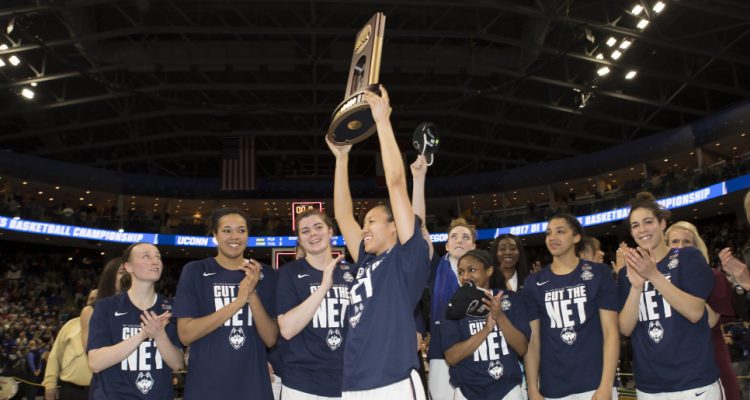By: Steven Tucker
Yesterday, the UConn Women’s Basketball team touched down in Dallas, TX to compete in the program’s 10th consecutive Final Four, and 18th in program history. With 111 consecutive victories, the Huskies are two away from winning their unprecedented fifth consecutive national championship, their 12th all-time.
To the naked eye, UConn has a clear monopoly on the game of women’s basketball. Seemingly nobody can stand toe to toe with the mighty Huskies, whose dominance is nearly incomparable to any other major sports program in history.
With success comes criticism. Internet trolls and a minority of professional sports writers alike have found fault with the Huskies’ continued streak of excellence, calling it bad for the game of women’s college basketball. Misogynistic messages pepper comment sections of social media posts highlighting achievements that are worthy of celebration, regardless of the sex of the human being wearing the jersey.
One skill that a school like the University of Connecticut develops in its students is critical thinking, which, according to dictionary.com, is “disciplined thinking that is clear, rational, open-minded, and informed by evidence.”
So what does the evidence say about dominance in college basketball?
Start with the raw data. On the men’s side, UCLA is the greatest dynasty in the sport’s history. 11 national championships, including seven straight titles from 1967 to 1973. 10 of those titles were earned under the leadership of the Wizard of Westwood himself, John Wooden. An 88-game winning streak from 1971-1974 (that has since been surpassed twice by the UConn Women) capped more than a decade of dominance for the Bruins.
Was UCLA’s dominance bad for the sport of men’s college basketball? Let’s take a look at the 1964 NCAA Division I Basketball Tournament: the first championship victory for the UCLA Bruins.
The tournament featured a field of 26 teams, a far cry away from today’s tournament, which features 68 if you include the First Four games. Including a third place game in each region and a national third place game, 29 matchups were contested in 1964. Today, 32 games happen in the First Round of the tournament alone.
The championship game of the 1964 tournament was held in Kansas City’s Municipal Auditorium, a venue that, today, seats 7,300 permanently, expandable to 9,987. Last year, 74,340 fans packed into Houston’s NRG Stadium to watch Villanova face off with North Carolina for the national championship.
From a macro perspective, both UCLA and UConn’s dominance has represented a coming of age in their respective sports.
Because of UCLA’s dominance in the men’s game, other programs had to improve if they had any chance of staying competitive with the best in the game. Schools like Duke, Kentucky, and Kansas, the latter two of which had won national championships before UCLA won their first, would rise to the occasion, and the sport would continue to grow throughout the years into the mammoth that it is today.
Similarly, programs in women’s basketball have had to grow to stay competitive with UConn. Fans can see the product of that growth in teams like Notre Dame, South Carolina, Baylor, Stanford, and Maryland: teams that have become the resident “blue bloods” in women’s basketball along with the Huskies.
Last season, Indianapolis was host to three programs making their first ever Final Four appearances: Washington, Oregon State and Syracuse. UConn’s 2017 Final Four opponent is a Mississippi State team that the Huskies beat by 60 in last year’s Sweet 16. To make it to Dallas, the Huskies defeated an Oregon Women’s Basketball program that previously had not advanced passed the second round of NCAA Tournament play. And nobody can forget the Cinderella story that was Quinnipiac this tournament.
What does all this mean?
The UCLA men’s basketball program redefined expectations for the sport. To be the best, an entirely new set of qualifications had to be met. Led by Wooden, the Bruins created a whole new game, and other teams eventually beat them at it.
The same holds true for UConn. For all the tournaments that have been won since 1995, there have been plenty lost. Turn the history book of UConn Basketball back a few chapters, and you see a Baylor program led by Britney Griner: a force that not even the Huskies could stop.
The bottom line is that every year, UConn Women’s Basketball has to get better to stay ahead of the pack. It’s lonely at the top, and everyone wants the spot that you have. When you reach a certain level of achievement, complacency becomes your worst enemy.
But the Huskies, led by Geno Auriemma, never settle. Especially this year, after losing one of the most dominant forces in sports history in the “Big Three” of Breanna Stewart, Moriah Jefferson and Morgan Tuck.
To continue winning this year was no easy task, and a pair of close calls at Florida State and Tulane were evidence of that. One of the most dominant eras in sports history nearly came to an end, but in response, the Huskies only got better and never looked back.
In a season that has defied expectations, UConn has the opportunity to solidify itself as the greatest dynasty in college basketball history by winning their NCAA Division I-record 12th national championship. The amount of work that each of those titles has taken should be appreciated, not dismissed.
UCLA helped take men’s college basketball to new heights through their dominance, and we’re seeing UConn take the women’s game through the same growth.
We are all witnesses to history. Appreciate it.


